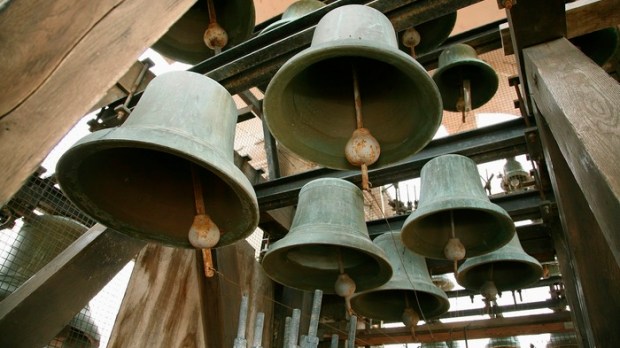Much has been written on the horrors committed in the name of equality, freedom, and fraternity during the French Revolution. Although nobody doubts that 1789 definitely changed the face of the world, and that from it a new perspective emerged on humanity and its fundamental rights (some would say only to die immediately right after, in the guillotine). What is less known is that the bells of the cathedral of Notre Dame played an interesting yet sad role in the revolution. The revolutionaries seized all the cathedral’s bells but one, melting them to make cannons, bayonets and more guillotines. Only in 2013 did the cathedral finally manage to replace them all. These new bells, like the original ones, have names, and have been blessed.
- Emmanuel: This is the only bell that survived the onslaught of the revolution. It is not clear, of course, if the revolutionaries decided to leave it there out of respect, or if they simply could not get it off the belfry, since it weighs thirteen tons. This bell is in charge of marking the hours of the day and special events.
- Marie: Obviously, its name is an homage to the Virgin. It shows engravings with the phrases “Je vous salue Marie,” in French, and “Via viatores quaerit,” in Latin (also inscribed in all the other bells too), next to an image of the Baby Jesus surrounded by stars and a relief with the Adoration of the Magi. It weighs six thousand kilos.
- Gabriel: On this bell, one reads the first sentence of the Angelus. It also shows 40 circular lines representing the 40 days of Jesus in the desert, and the 40 years of Moses crossing the Sinai.
- Anne Genevieve: The name is a tribute to Saint Anne, the mother of the Virgin Mary, and Saint Genevieve, the patron saint of Paris. Here one finds the second prayer of the Angelus. In it, we find three circular lines that represent the Holy Trinity and the three theological virtues.
- Denis: Named in honor of Saint Denis, the martyr who was also the first bishop of Paris, this bell includes the third phrase of the Angelus, “Behold the handmaid of the Lord.” There are also seven circular lines representing the gifts of the Holy Spirit, and the seven Sacraments.
- Marcel: Saint Marcel, the ninth bishop of Paris, known for his tireless service to the poor and sick, lived in the fifth century. The bell that bears his name, as a tribute, also has engraved upon it the fourth sentence of the Angelus, “be it done unto me according to thy word.”
- Étienne: This bell recalls the old cathedral church of Paris, which preceded the construction of Notre Dame, which was dedicated to St. Stephen, (Étienne, in French), the first martyr. On it is the fifth sentence of the Angelus, “And the Word was made flesh.”
- Benoit-Joseph: Its name is a tribute to Pope Emeritus Joseph Ratzinger, since 2013 – the year of the Jubilee of the Faith decreed by Benedict XVI – was also the year of the 850th anniversary of the Cathedral. On it, one reads the sixth sentence of the Angelus, “and dwelt among us.”
- Maurice: Maurice de Sully was the bishop of Paris who laid the first stone, in 1163, for the construction of the Cathedral. It includes the inscription “Pray for us, Holy Mother of God.”
- Jean Marie: The tenth bell of the cathedral of Notre Dame bears the name of Cardinal Jean-Marie Lustiger, who was the bishop of Paris from 1981 until 2005, and on it reads the eighth and last sentence of the Angelus, “that we might be made worthy of the promises of Christ.”
New bells are washed with holy water and then anointed inside and out with chrism oils. Then it is prayed:
“Lord, from the beginning of time your voice has called to us, inviting us to communion with you, teaching us the mysteries of your life, guiding us on the way to salvation. With silver trumpets Moses summoned Israel to gather as your people. Now you are pleased that in the Church the sound of bells should summon your people in prayer. By this blessing accept these bells into your service. May their voice direct our hearts toward you and prompt us to come gladly to this church, there to experience the presence of Christ, listen to your word, offer you our prayers, and both in joy and in sorrow be friends to one another. We ask this through Christ our Lord.” – From the Book of Blessings
A very brief video of the blessing of the bells at Notre Dame:

